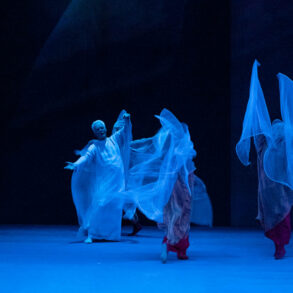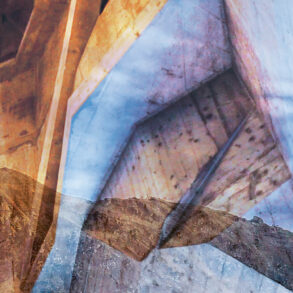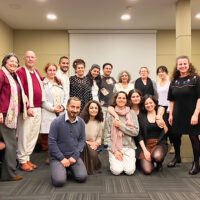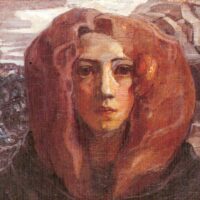The exhibition at the Goetheanum features about 20 works of art by the Russian painter Margarita Woloshina. January 31, 2022 would have been her 140th birthday. She left behind a large collection of pictures when she died in Stuttgart in 1973. She contributed to the development of the anthroposophical artistic impulse since its beginnings. Curator Barbara Schnetzler wanted to know what effect these pictures have on young people and had a conversation with two students from Chile. Here is an excerpt.
Margarita Woloshina gained recognition as a portrait painter from an early age. It was during this time that she painted her self-portrait, wasn’t it?
Josefa Vial Brizzi The portrait of the young artist (see Miss Sabashnikow – Anthroposophy, Russia and Christian Painting ) is set in a stony landscape. The predominant color is brown. The face looks at us with sad, almost nostalgic eyes – with eyes that want to tell us something, but which hide as if behind a mask. They speak through solid and clear shapes.
Camilla Conreras She’s looking out of a kind of cave, but that’s probably the architecturally painted, voluminous hair. Behind her head, the shapes of the Second Goetheanum appear in the rocks?
Barbara Schnetzler That’s not really possible, because Rudolf Steiner developed these shapes much later. At the time of this portrait, she had not yet met him.
A leap in time to ‘Orpheus’, a picture she painted when she was older. What do you see?
Brizzi Now there are colors, no longer structure. The picture is filled with movement. It looks like it’s out of this world. There is a certain movement in all the shapes.
Conreras The shapes aren’t complete. They go on and on and I see a bull, an eery snake, an eagle and a center figure. I am moved when I look at it and things become visible.
Schnetzler Orpheus tames the wild animals with his music, among which a lion was especially significant. Woloshina struggled a lot with the lion, wiping it away again and again. Another painter added the lion later. It was not painted by Woloshina.
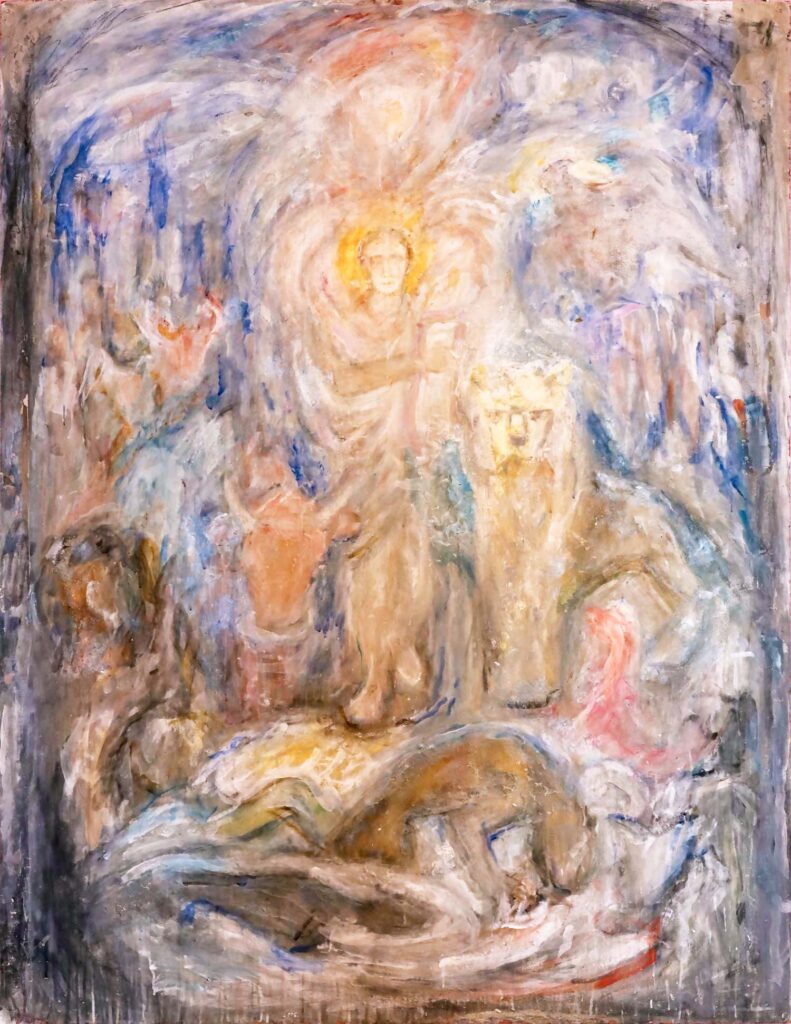
Lion head, added by D.Templeton
What is your perception of the color mood in the picture?
Conreras All colours lean towards grey.
Schnetzler In her previous pictures, the entire color palette is used, and now, towards the end of her life, grey emerges.
Brizzi I like this picture. It is always new, it animates and reveals the mood of her soul – very different from her self-portrait. There’s a secret to it, and that’s what makes it interesting – I can’t make it out.
Conreras Movement is an element.
Brizzi Could she perceive the spiritual in the physical?
Schnetzler She doesn’t talk about it. But even as a young student, she questioned the naturalistic painting style of her teacher Ilya Repin and wrote in her diary: “Does it make sense to repeat what already exists? A completely different kind of art has to be created that reveals an unprecedented world.” Later she writes: «Transforming the experience of emotion into colour, into the movement of colour, which becomes rhythm and finally shape. […] But the idea […] must always be sensed as something essential, as a whole.” Through the impulses of anthroposophy, she succeeds in entering deeper and deeper into the essence of color itself. Her consistent search probably led her to a more refined perception. In her last portrayal of Orpheus, shortly before her death and almost blind, she incorporated her personality into the picture with all her life’s achievements, exhausted and free. Unfortunately, this picture from the art collection at the Goetheanum could not be made available for this exhibition.


On the left a detail of the picture ‹Orpheus›; right: Orpheus (sketch), approx.1940, watercolour, 49.5×36.5 cm
Margarita Woloshina was given the task of painting the Egyptian in the small dome of the First Goetheanum. What effect does this portrayal have on you?
Brizzi I love this picture, especially the transparent colours in the background. This creature is looking at me in a friendly way. It looks alive to me.
Conreras The eyes are so deep, the figure catches my attention, the eyes follow me no matter where I am. The will appears completely controlled by the framed beard. The eyes make me feel compassion.
Brizzi I feel looked at and seen. The eyes get my full attention.
What is the physicality of this Egyptian?
Brizzi The body has an ethereal quality. It is a transparent being and opens up a space for me that I can confide in. My true self can stand before it. It looks very ethereal.
Schnetzler When I look into those eyes and include the mouth, everything comes alive. The body almost intertwines with the background.
Brizzi The mouth in particular seems alive. The pharaoh may be in the middle of a ceremony. She paints this being as if she herself experienced this period in time.
Schnetzler Most of her works show portraits, with which she initially earned her money. Here we see Portrait of an Artist by Strakosch Gisler (1938).
Conreras This portrayal also has an ethereal effect.
Brizzi I really think can see more – this man is not a human in this physical world. The different layers show auratic colors. If you look from afar, we see a glow, we see the etheric body.
Conreras The layers are the colors of the aura.
The body is completely intertwined with it’s surroundings – where is the physical body most clearly visible?
Conreras On the skull, on the cheeks, on the forehead – the body is almost dissolved in a bright, transparent white.


Left: Maria with Child III, undated, painting on wooden panel, 28×25 cm; on the right a detail of the picture ‹Orpheus›
In the second half of her life she begins to paint motifs from the Gospels. Many altarpieces were created for the Christian community. What is your overall impression of this abundance of pictures?
Conreras The spiritual world.
Brizzi Her spiritual life – everything is in motion, everything is limitless. She has a special gift for drawing eyes. This Madonna here is beautiful and her eyes see you from every angle.
Schnetzler She felt at home in the religious sphere and painting icons was special to her. She wanted to paint contemporary icons out of free insight. Icon painting is based on the secret of colour layering, the application of which was a sacred procedure. She herself learned this in Russia from an icon master. In her works she transforms this painting style, sets it aside and unveils the painted secrets.
Brizzi Everything is painted in layers, here in a hightened manner. This technique creates a solid structure and adds rhythm to the image. Why do you think she put fire and water, sun and moon in one picture? What does that symbolize?
Conreras Perhaps in this moment of the Mystery of Golgotha everything comes together and the opposites become visible. Perhaps she would like to show that we humans have two effective basic forces within us?
Do you recognize a time reference in her work, is it art of our time?
Conreras This painting is very contemporary because it shows people something. The painter wants to make us aware of how important it is to seek out the topics shown within ourselves. She tells us that we should learn to look not just at was is on the surface, but deeper within. Learning to look beyond the physical limits has to do with this period in time.
Brizzi It is the visualization of the ethereal. This is new and takes us further. Art should be completely free, there should be no rules.
Many people think that layer painting is anthroposophical art.
Brizzi I have sometimes had the impression that with anthroposophical artists everything looks the same, but with this painting here everything is real, it seems animated and alive.
Schnetzler Margarita Woloschina and others developed layer painting and color perspective together with Rudolf Steiner and thus developed a completely new style of painting. In her ethereal landscapes, she stimulates the germs of a new style of painting that has not lost its relevance to this day and would like to be further developed. Her diary entries and pictures show that she always felt pushed towards the new and was a seeker all her life.
Cover photo: Detail from ‹Orpheus› by Margarita Woloshina
Exhibition Margarita Woloschina Painting: “… morning approaches silently.”, November 19, 2021 to April 24, 2022, Goetheanum Art Gallery, Dornach





